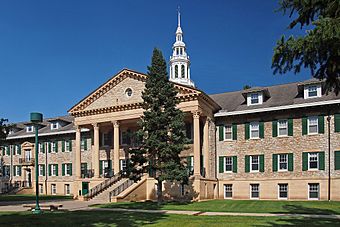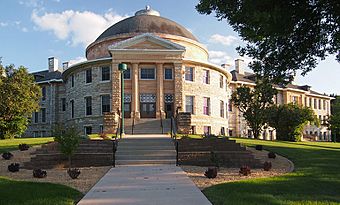Minnesota State Academy for the Deaf facts for kids
Quick facts for kids Minnesota State Academy for the Deaf |
|
|---|---|
| Address | |
|
615 Olof Hanson Drive
Faribault
,
Rice
,
Minnesota
55021
United States
|
|
| Information | |
| Former name | Minnesota School for the Deaf |
| Type | Public |
| Established | 1858 |
| School district | 160 |
| Superintendent | Terry Wilding |
| Director | Jody Olson and Ryan Johnson |
| Faculty | 18 |
| Grades | Pre-K to 12+ |
| Age range | 12 months to 22 |
| Number of students | 94 |
| Language | American Sign Language and English |
| Color(s) | Maroon and gold |
| Athletics | Volleyball, Football, Cheerleading, Basketball, Track and Field. |
| Athletics conference | Great Plains Schools for the Deaf |
| Mascot | Trojans |
| Newspaper | Companion |
| Website | https://msad.msa.state.mn.us/ |
The Minnesota State Academy for the Deaf (MSAD) is a special public school for deaf and hard-of-hearing children in Minnesota. It is located in the city of Faribault. The school is run by the state to give students a great education in an environment where they can thrive.
Contents
History of the School
The story of MSAD begins shortly after Minnesota became a state in 1858. A local leader named George E. Skinner suggested that a school for deaf children should be built in Faribault. The state government agreed, but only if the town provided 40 acres of land for the school.
The people of Faribault quickly donated the land. However, because of the Civil War, nothing was built for five years. In 1863, the government finally decided to open the school. They hired Roswell H. Kinney, a teacher from the Ohio School for the Deaf, to be the first superintendent.
Since there was no money to build a new school right away, they rented a building in town. The school officially opened on the second Wednesday of September 1863, with just eight students.
Name Changes and Growth
The school was first called the Minnesota School for the Deaf and Dumb. In 1866, a department for blind students was added. The school's name was changed to the Minnesota School for the Deaf in 1902. Finally, in 1986, it became the Minnesota State Academy for the Deaf (MSAD).
Historic Buildings
Two of the school's buildings are so important that they are on the National Register of Historic Places. Both were designed by a famous architect named Clarence H. Johnston, Sr..
- The Administration Building/Girls' Dormitory was built in 1912.
- Noyes Hall was built between 1902 and 1910.
In 2018, a new dormitory called Wilkins Hall was built. It was named after Blanche Wilkins Williams, the first African American student to graduate from the school.
Who Attends MSAD?
MSAD serves students from all over Minnesota who have some level of hearing loss. Students can be as young as babies or as old as 22.
The school provides an education where students learn in both American Sign Language (ASL) and English. All teachers are specially trained to work with deaf and hard-of-hearing students.
Families can choose to send their child as a "day student," who travels to school each day. Or, they can be a "residential student" and live in a dormitory during the school week.
Programs and Activities
MSAD offers many programs to help students succeed. These include:
- Classes from preschool all the way through high school.
- Housing in dormitories for students who live far away.
- Transportation to and from home.
- Therapies like speech, occupational, and physical therapy.
- Counseling and support.
- Fun activities like sports and clubs.
The school uses different teaching methods, including ASL, spoken English, and Protactile for students who are deafblind. Students can also join extracurricular activities like sports teams and student government.
The School Campus
The MSAD campus is a large, 47.5-acre area in Faribault. It has many buildings for learning and living.
The academic buildings have classrooms and labs designed for deaf and hard-of-hearing students. This makes learning easier and more accessible for everyone.
The campus also has dormitories where students can live. These dorms are comfortable and help students build friendships and feel like part of a community.
Living at the School
MSAD is a residential school, which means many students live there during the week. The school has two dormitories for students who live more than 20 miles away.
Residential students usually arrive on Sunday evening and go home on Friday afternoon. Their local school districts provide bus transportation. Students who live closer to the school are called "day students" and travel to school each day.
Sports at MSAD
The school, known as the Trojans, offers many sports for students. This helps them stay active, learn new skills, and work as a team. The main sports are:
- Football
- Volleyball
- Basketball
- Track and Field
If a student wants to play a sport not offered at MSAD, like hockey, they can often join a team at a nearby school. This gives them even more opportunities to compete and have fun.
Athletic Facilities
MSAD has great facilities for its sports teams.
- Maurice Potter Field: This is the on-campus field where the football team plays its home games.
- Lauritsen Gymnasium: The volleyball and basketball teams practice and play their home games in this gym.
- Bruce Smith Field and Ted Nelson Track: The track and field team practices on campus but competes at this track located in town.
Famous Athletes from MSAD
Several talented athletes have attended the school, including:
- Ronda Jo Miller
- Maurice Potter
- Tasha Lemke
- John Dolezal
- Calvin Rausch, Ryan Johnson, and Steven Hubmer



